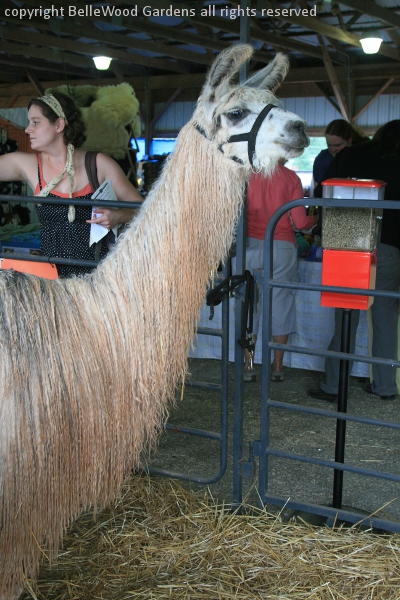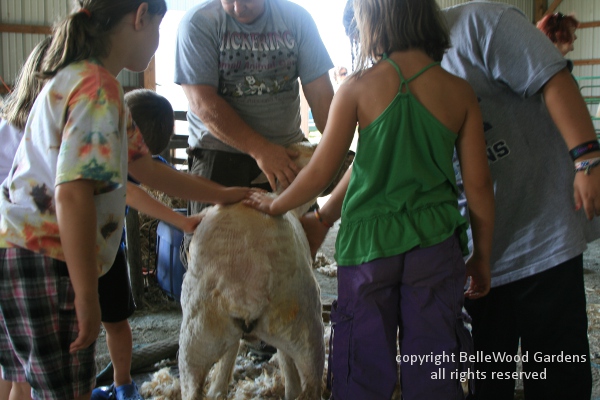
Saturday, 8 September 2012
Sheep Festival - Part II
Off to the Garden State Sheep Breeders Association Sheep and Fiber Festival. As you'd expect, it's mostly about sheep. But if you've been paying attention, its a sheep and fiber festival so while there were no yaks or samoyed dogs there were other-than-sheep fiber animals.

Like the classic mohair goat, with elegant brilliantly white fleece, and magnificently curly locks and sweet faces. Native to Turkey, Angora goats have been known for three and a half millenia. Their fleece grows rapidly and constantly, year-round. Basically, quality varies with the age of the animal, kid being finer than yearling, and adult heavier. Bucks have coarser fleeces than does.

Then there are Angora rabbits. I was walking along the outside of a barn and saw this woman with a pile of fluff.
Could not figure out what it was so I walked over and asked. An English Angora rabbit that she'd brought out so
he could nibble on the grass and she could do a bit of plucking. What a woolly rabbit - fur on his feet, on his ears,
on his face, as well as on his body. This is the softest, fluffiest fur you've ever touched. Up to 12 ounces / rabbit / year.

English Angora rabbits shed their fur several times a year. They can be plucked rather than shorn.
They also require more upkeep than a sheep, needing regular combing to keep their fur from matting up.

And llamas. At home in the Andes they're pack animals. Sure footed, and easier on fragile landscapes, I've seen them employed that way in the Colorado Rocky Mountains. But here in the lowlands of New Jersey llamas are pasture ornaments, with wool. The issue is that every one is different: do you shear or do you pluck? Is the individual llama single coated or double coated? Is it a huacaya or woolly type llama or one of the small percentage of suri llamas with long, fine locks of fiber that hang, curtain-like, down their neck and body.

.

Perhaps you'd rather work with alpaca, which have wonderful soft, fine fleece. Just like llamas, most are huacaya, woolly, and only 10% or less are suri. Alpacas are not plucked, they're shorn, as are sheep.
Three scheduled sheep shearing demonstrations scattered throughout the day. Along about 1:15 p.m. I wandered over
to the far end of the barn and chose a nice hay bale to sit on in anticipation of the event. Hoyt Emmons is shearing. He's
an American Sheep Industry Association certified shearer from Pennsburg, Pennsylvania, and what a terrific presentation!
He didn't just clip but explained how and why sheep are sheared, why he was doing what he did, and got the children involved.

He had a young girl choose which sheep in the pen she wanted him to shear, then had her help with the gate.
He sat the sheep down on his blanket / tarp, and explained that they then become very relaxed, calm and quiet.

First, clip the dirty wool around their butt. Next the neck, then the belly. Keep the skin a little stretched
to reduce any chance of nicking it. Shear up to the ear, up to a nipple, then back off again, if the clippers
were moved over any bumps or skin tags there's the risk of nicking, hence bleeding. There are different
clippers, anywhere from 8 to 22 teeth. The coarser ones leave more wool on the sheep, good for winter.
Hoyt shears from February through to late October, working in both Pennsylvania and New Jersey.

Nearly done. The ewe has been turned, flipped, spun around - and seems very placid about it all.

Towards the end Hoyt invited children and adults to come and help him shear. He's really controlling
the clippers but the children do get "hands on" experience. Three passes, a complimentary "Good job!"
and a handful of the wool they've sheared as a memento. I don't know who had more fun, adults or children.

Another of Hoyt's "did you know" informational tidbits was about lanolin. Sheep have 8 of these sebaceous
glands: one in the corner of each eye, between their toes, and two in the groin area - near the udder on ewes
and the scrotum on rams. With the shearing is complete, he invited everyone to come up and feel the lanolin.
Good timing. The shearing finished in about 30 minutes, just in time for a sheep herding demonstration. Border collies, first bred along the frontier between England and Scotland, are compulsive herders, with instincts so intense -as you'll see - they'll herd anything that flocks. Gene Sheninger from Wayside Farm in Boonton, New Jersey, is here with two of his trained working dogs, bred to a performance standard rather than for the show ring. He's been training border collies for stock work since 1985. And do his dogs want to work!. It was amusing. Gene would be talking to someone, the sheep would be bunched at the far end of the field, and off a dog would go, entirely on his own, to bring them in. It's a flock. They should be herded.

Outrun To begin the run the dog is sent towards the sheep, swinging wide as he gets closer
to them, then moving in behind the sheep to gain control. It's beautiful to watch the dog working the sheep.
The dogs work to a shepherd's whistle, a different note for each dog. One sounded like a bobwhite.

Lift This is when the sheep begin to move under the dog's influence.

FetchThe dog brings the sheep down the course towards the handler.

Gene keeps about 150 Katahdin and Katahdin/Dorper cross sheep, 30 or so that are used strictly for dog training.
These are hair sheep which do not produce wool, or only a little bit that they shed. See how scruffy the last three look?

Pen / Penning The sheep are driven into a small fenced enclosure with a gate. That'll do. All done.
Border collies are maniacs. One belonging to friends of mine would fetch a tennis ball, drop it at my feel, then crouch there with this hypnotizing border collie stare until I threw the ball. Again. And again. And again. Endlessly. Border collies are fanatics about herding. Some only want to herd sheep. Others want to herd anything that flocks. Like ducks. As was demonstrated with this fivesome of Indian Runner ducks, a breed that carries itself upright and is reknown for its egg laying abilities.

That border collie stare. Total focus on the job at hand - move them ducks as the whistle blower directs.

Around the field, then into and through the lattice chute. What next? Well, if dogs do agility
 . . . . .
. . . . . 
how about ducks? It works! Herd them onto the teeter-totter . . . . and . . . . tilt! and the ducks and border collie are off and running again.
A great day. My BelleWood Gardens entry with information about the sheep may be found here